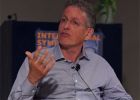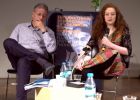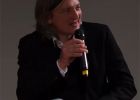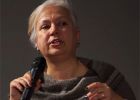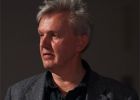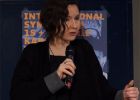Flusser Studies 22 – December 2016 / Special Three Part Issue / Thematic focus: Translingual Writing and Proceedings of the symposium „Transcoding Flusser“ (April 15 and 16, 2016)
Part I: Translingual Writing, Translation and Self-Translation
Travels through Russian in English: Dale Pesman, Maria Tumarkin, Maxim Shrayer and Gary Shteyngart
The ‘travels through Russian in English’ of the four authors discussed here took place in different directions, and at different times. American artist Dale Pesman’s Russia and Soul (2000) is a work of anthropology, a retrospective mining of Pesman’s two years in the Siberian town of Omsk, 1990-1992, for what she learnt there of Russian dusha (or soul). Australian historian Maria Tumarkin’s memoir Otherland: a journey with my daughter (2010) recounts six weeks of travel with her 12-year-old daughter, Billie, in Russia and Ukraine in 2008 – Moscow, Kiev, St Petersburg, Babi Yar and Tumarkin’s birthplace of Kharkov – against the background of the author’s migration to Australia with her parents in 1989, aged 15. American literary scholar Maxim Shrayer’s Leaving Russia: A Jewish Story (2013) is an account of the nine refusenik years, 1978-1987, from his eleventh till his twentieth birthday, in which he and his parents waited for permission to leave the Soviet Union. Finally, American writer Gary Shteyngart’s Little Failure (2014) is a narrative of his growing up in the Soviet Union and the United States, after his migration there aged 7 with his parents in 1979. Pesman is the only one of these authors not born in the Soviet Union, and not from a Russian-speaking background. Her language travel, then, took her into Russian from (American) English, whereas the other three all moved initially from Russian into (American or Australian) English, with later return trips to post-Soviet Russia and Russian. All four authors are Jewish, and write of Russian-Jewish experience – in Pesman’s case, most obliquely, of how Jewishness shadows her provisional, adopted Russianness. All four texts invoke ways of being – cultural, psychological – which are possible in Russian, that is, among Russian-speakers, and equally, ways of being that emerge between Russian and English. Their engagement with these lingua-cultural ways of being is the focus of my paper.
Literarische Selbstübersetzung im Kontext weniger verbreiteter Sprachen – ein zweischneidiges Schwert?
Self-translation is a common practice among minority language writers, who often consider their works an active contribution to language maintenance. However, translation reveals itself to be a double-edged sword in contexts of lesser-translated languages. This article aims to show that there is an urgent need for self-translation studies to explore the link between self-translation and language maintenance.
Literary Translingualism in Switzerland: Pierre Lepori and Beat Christen
The Swiss writer Conrad Ferdinand Meyer had two languages at his disposal, German and French. He hesitated, but in the end he opted to write in German. His decision was deeply affected by the outcome of the French-German war of 1870, which led to the unification of Germany. Contemporary Swiss writers do no longer have to grapple with such heartbreaking decisions. Quite the opposite is the case. In the last few decades, new forms of translingual writing have come into being. They have created a dense dialogical net across the country linking the four linguistic regions with each other. In this paper I would like to discuss two significant examples of this new form of translingual literature. Pierre Lepori combines Italian and French and Beat Christen writes in German and French.
Selbst-Übersetzung und mehrsprachiges Schreiben
In this e-mail exchange, Christen focuses on his career as a bilingual writer. He started out with German poetry, but is now writing in both German and French moving back and forth between the two languages. Christen defines self-translation as a form of recreation. Differences between languages are not a drawback but activate the artist’s creativity.
Ölflecken - Un beau jour me hisser - Deux fleurs s’envolent - Orange - La méthode SAC
Scrittura bilingue
In this interview, Pierre Lepori focuses on biographical reasons for his practice of bilingual writing, the relationship of his two writing languages (Italian and French) to each other and its evolution in the course of his career as a writer and translator.
Translation as an Act of Freedom – Vilém Flusser’s Philosophy of Translation
In this text I want to define Flusser’s notion of translation. The basis for my essay are his writings on language and translation. Focussing on the power and strength of language I will relate these writings to Ernst Jünger’s book Lob der Vokale which Flusser mentions in the bibliography of Língua e Realidade. In the first part of my text I deal with the aspects of linguistic domination and submission that arise when Flusser uses a specific language. They are two sides of the same medal. In the second part I discuss Flusser’s methods of translation more precisely. At this point I will take up his concept of ‘fragrancy’ (fragrância) which points in the same direction as Walter Benjamin’s ‘way of meaning’ (Art des Meinens). Lastly I argue that Flusser’s translation activities have to be understood within his dialogical concept of freedom as an opening towards the other.
Part II: Transcoding Flusser: Synthetic Thinking. The Hague April 15 & 16 2016
Cotton Wool. On Flusserian Methodology and Terminology
Flusser’s attempt to cross-fertilize the disciplines, to synthesize philosophy, art and science, relies on the use of hybrid multifocal terminology. This implies the use of different strategies: horizontal expansion through multiple successive translation, vertical segmentation through etymology, integration of conceptual opposites, crossbreeding between disciplinary areas, exploration of the phonetical and visual side of words, wordplay. Furthermore, these main strategies are not used on their own, but combined in different and always changing ways with each other. The borders of words are not fixed. They overlap, mix and merge. I would like to explore Flusser’s writing and thinking styles in order to approach and understand the challenges stemming from his idiosyncratic innovative methodology.
"Für eine Phänomenologie des Fernsehens" I: Edmund Husserl, Martin Heidegger, Jean-Paul Sartre, Immanuel Kant und Günther Anders
Although Flusser does not explain and develop his philosophical and methodological claims on the first three pages of his mini treatise „Für eine Phänomenologie des Fernsehens“ (1997 <1974>), there is enough evidence for Flusser’s fundamentally phenomenological credo. The philosophers of Flusser’s implicit references can be unmistakably detected: Edmund Husserl, Martin Heidegger, Jean-Paul Sartre, Immanuel Kant and Günther Anders. On the one hand, Flusser appears to be strongly rooted in the phenomenological tradition. On the other, in a text on Husserl’s (late) philosophy written in 1986/87, Flusser reveals that he had changed his mind in the meantime turning to a sociology of media that dispenses with the phenomenological stance that was the main aim of his thinking on media in the 1970ies.
"Für eine Phänomenologie des Fernsehens" II: das Schicksal eines Texts und der Wechsel zur Fotografie
Although Vilém Flusser’s text „Für eine Phänomenologie des Fernsehens“ is only 21 pages long there is no other text in his oeuvre that shows the same concern for philosophical and methodological reflection. A first, incompletely elaborated version for the New York symposium in January 1974 was published with a four years delay. However, the definitive version Flusser provided has not been published. A new object of research is superimposed onto the unlucky old enterprise of a theory of television.
"Für eine Phänomenologie des Fernsehens" III: Nam June Paik und eine künstlerische Phänomenologie
When Vilém Flusser arrived at the conference held at the Museum of Modern Art in New York in January 1974 he did not know that an artist was responsible both for the conception and the title of the meeting. Flusser aspired to develop his media theory differently and in front of a completely different philosophical background as McLuhan. Nam June Paik, at that time in his zenith, most likely influenced Flusser philosophically as well as in terms of art examples and much more than Flusser was ready to admit in his short reference to one of Paik’s early non-electronic pre-video films. It is a bit strange that Flusser shied away from the confrontation with art in and with television. It is all the more important to determine the theoretical space that Nam June Paik must have opened to Flusser and others. Against this background it becomes clear that Flusser was able to approach the heritage of phenomenology in a more open und artistic, that is, in a more literary and essayistic way.
Encountering Bibliophagus: An Aesthetics of Reading
This essay explores Flusser's implicitly articulated aesthetic approach to reading which can be found throughout his writing. The essay examines how this approach is an attempt to return us to the questionability of our existence, where reading is understood as an art of living, rather than an accumulation of knowledge.
Art as Acting Against the Program of the Apparatus
Vilém Flusser is one of the first scholars to address the systems of technical media, as well as the biotechnological manipulation of the living world, in relation to the issue of programmability. In this regard Flusser questioned the position of the actor, the operator or perhaps the creator in these systems. If the functionary and the apparatus merge into a unit and apparatus has its program, what is the role the artist if he or she is not just anyone who is exhausting the options offered by the program? In the paper the functionary of the apparatus of the camera and the “creator” in the field of biotechnics are compared in order to establish the similarities in both “creative” practices of an (artistic) photographer and of a biotechnological artist, as well as discuss the similarities with other artistic practices discussed by Flusser. The apparatus functions as “intelligent machine” thus it has certain power. The subject involved in the game of the apparatus is subjected to its structure. The question is, how to establish the critical stance, how to act against the apparatus. This transposes the notion of an artist as a supposed creator to the notion of an artist as the one who resists the structures of power.
From Science to Fiction. Considering Vilém Flusser as an Artist
In Flusser’s biography as well as in his writings one can easily detect an alienation from a, let’s say, traditional and conservative dealing with science in general and the academic world in particular: There is a growing rejection of scientific writing and a growing sympathizing with unacademic essayistic writing. One well known climax of this development is his collaboration with Louis Bec creating the „Vampy“ as they called it – the Vampyroteuthis Infernalis, a work that Abraham Moles called philosophy-fiction. Parallel to this, Flusser’s aim is to replace objects in art exhibitions through communicological processes. Now, being an expert in communication, could that mean allready that he is thinking of himself as the artist of the future? Last not but least, he is talking about alternative realities that could arise from „zero dimension“, from the endpoint of his media chronological model, with the help of artists and, on the other hand, he writes in several letters that he wants to translate theory into practice – maybe as one of the artists who are creating these new and unexpected realities?
Raising the Temperature of the Conversation in the 21st Century
The main goal of this presentation was to connect our wireless culture populated by “smart objects” and Flusser’s predictions for a telematics society, as well as to examine the inversions he envisioned in the exchanges between art and science. Seven artists have been included in the slide presentation: Eduardo Kac, a pioneer of Bio Art eroding boundaries between subject and object; Paul Miller, who creates sound pieces from scientific data; Laura Poitras’s documentary films and exhibition about surveillance and the use of remote technologies in war as well as Andrea Fraser’s institutional critique; Giselle Beiguelman articulating the concept of techno-cannibalism; Lucas Bambozzi exploring the invisibility of electronic waves, issues of obsolescence and waste; and the work of Cuban artist Ernesto Oroza’s notion of “technological disobedience”.
Meaning and Agency in the Universe of Technical Images
This presentation is about the differences between traditional or handmade images, technical images made by apparatuses, and dialogical, interactive images. What Flusser called technical images we call analogue images. Digital images are understood by Flusser under the name of dialogical or interactive images. Flusser wasn’t yet able to make this clear distinction in 1985 when writing Into the Universe of Technical Images, but this is how both types of images developed since then.
Postscript
Flussers In the Universe of Technical Images was published in 1985, and was part of a surge of speculative, science-fiction like books and films about the information age that was slowly but surely emerging. Related titles include William Gibsons Neuromancer (1984), Jean Baudrillards Fatal Strategies (1983), Paul Virilio’s Negative Horizon (1984), and James Camerons The Terminator (1984). In the book Flusser tries to speculatively come up with a set of concepts that would allow him to enter into the Universe of technical images that is slowly but surely coming about in the 1980’s. In Chapter 11 he makes a fundamental shift in his writing strategy, and decides to go beyond the philosophical project of inventing new concepts for new situations, and actually enter the Universe of Technical Images in order to become the future ‘telematic man’. The next 10 chapters are among the best ever written by Flusser and describe what he sees and experiences as telematic philosopher in UTI. He makes a distinction between traditional or handmade images, technical or machinic images and dialogical, digital images. This last category is interactive, democratic, open, divine, as is the corresponding telematic man.
Can We Think Computation in Images or Numbers? Critical Remarks on Vilém Flusser’s Philosophy of Digital Technologies
The article questions Flusser’s concept of the computational universe based on technical images. Emphasizing the role of the calculative, formal consciousness the article suggests a non-representational, non-hermeneutical approach to “calculating machines” as machines that allow to mechanize a certain type of thinking (mathematical thinking). At the same time, the article reformulates Flusser’s search for a new philosophy as a critical intervention into the programmed universe, arguing that this philosophy must not follow its technical logic, but find a way to reflect how different techniques and practices shape the numerical, imaginative and textual consciousness.
To Save Philosophy in a Universe of Technical Images
Philosophy, origin and apotheosis of the Humanist project, seems to have been surpassed in a world of extreme and ubiquitous automated processes. Automation threatens to truly “taken control”, and subordinate all human activity to the functions inscribed in the machine. The kaleidoscopticon of contemporary culture seems to indicate a return to pre-literate “magical thinking” but it is in fact a product of highly literate scientific, technical literacy. Flusser urges us to encounter the persistent importance of causal, textual thinking at work inside every apparatus to help steer the transformations, which are taking place in ourselves and in our world. Flusser makes this plea alongside a contention that linear, causal, conventional textual practices are no longer adequate to convey our ideas and experience highly in-formed by the new technologies. He exhorts us to use “technical images”. It becomes evident that Flusser’s project is to save philosophy, or restate the importance of philosophical practices, in an age where literacy has gone sub rosa. Using examples from Flusser’s experimental collaborations with artists Louis Bec and Fred Forest, this short essay will attempt to elaborate what Flusser means with philosophical practice, which uses technical images.
Denken neu denken mit Vilém Flusser
Flusser suggests synthetic images may free us from the tyranny of linear thinking, whilst calling upon us to engage actively in the new ‘Einbildungskraft’ or techno-imagination. The innovative dimension of this new form of synthesizing information might be the transcending, overcoming or undermining of dualistic patterns of thought. ‘Dedicated to synthesis of contrasts’ (1949) Flusser not only translated between cultural poles but strove for a ‘method of cognition [...] with aesthetic qualities’, ‘which extends beyond philosophy’ (1951). His poetically composed philosophy transcends the traditional opposition of art and philosophy. Yet, as ‘every technical revolution induces a new mankind which again designs a new technique’ (1991), the challenge facing us is more than merely thinking and acting in new technical ways, we must deliberately co-design. Thus, the transformation at hand may be discussed as a shift away from the dominance of thinking in dichotomies, indicating an interrelational understanding of the (re)programming of our environments and of ourselves in dialogue.
Part III: From Sigmund Freud to Hubert Damisch and Wilhelm Reich
Übersetzung, Wissen und Kultur in der freudschen Psychoanalyse und im Werk Vilém Flussers
This article aims to present Sigmund Freud and Vilém Flusser not only as two thinkers with biographical similarities, but mainly as two intellectuals of converging ideas. Both developed a critical analysis of the human unease (Unbehagen) mediated by the symbolic, and both, each in his own way, tried to find solutions to deal with this unease using language as an instrument. Both saw in translation an important instrument to overcome cultural boundaries.
The Unassimilable Image
This short essay considers Flusser’s thoughts concerning the relationship between image and language in light of Hubert Damisch’s Theory of /Cloud/. It explores the degrees to which the image—despite a flood of contemporary manifestations particularly of what Flusser called the ‘technical image’—remains resistant to textually based systems of communication and (scientific) knowledge. It proposes a necessary openness to the image where, given the nature of how sense is made regarding the multiple ways it can be approached or ‘read’, provisionality and indeterminacy are essential, positive attributes.
Considering linear perspective as a precursor to the technical image, the paper explores the sense in which the ineffable—seen as intrinsically related to Damisch’s notion of /cloud/—is inseparable from and perhaps essential to the representational systems signified by the camera or the computer. These emerge from a constantly developing ‘net’ of language through which knowledge about the world is defined and acquires its dizzying complexity. This net is regarded as intertwined with, yet of a different order to, the image. Flusser’s technical image locates this concept firmly within a linguistic system but such an image still has echoes of its origins, and is thus open to difference in terms of how it is approached and what can be drawn from it. This is a productive incompleteness. Some of the author’s visual works, which are thoroughly enmeshed with the thoughts that have led to such thinking, are represented and function as asides, responses, or counterbalances to the ideas explored in the text.
The Sixth Rung
Digital media and its effects on society have been widely discussed and questioned by many authors, for instance one’s additional self (selves) such as Facebook or Instagram and its later ways to behave virtually (Case 2014) or the effects of uninterrupted entertainment on memory, attention span and creativity (Harris 2015). Besides being an occupation during idle time, an internet connection and its gadgets have become an essential tool to accomplish some of the most ordinary tasks, such as track addresses or pay bills, as well as a powerful feature within the scientific-academic environment. The shift from analog to digital has probably been achieved. The philosopher Vilém Flusser argued that the inadvertent use of “technical” media could substantially change the way we process information, the way we think. Although Vilém Flusser had already highlighted the importance of idle time during which critical thought takes place, it is only during spare time that one is able to re-think about what was done, criticize it and adjust accordingly. Flusser’s major outcome is a possible reshaping of historical consciousness.
The following text discusses the gains and losses of cognitive dimensions after the digital shift and its impacts on the architectural design process, based on Vilém Flusser’s “hypothesis that human civilisation has seen two fundamental turning points since its beginning. The first (…) may be defined as ‘the invention of linear writing’. The second (…) may be called the invention of technical images”. (Flusser 2000; 7). The research looks at new media within the architectural design process: tri-dimensional modeling versus two-dimensional representation, use of smartphones and other interactive media by constructing analogies between writing and architectural representation, and how these new procedures are radically changing consciousness and the task of developing knowledge.
How to Face the Terror of Reason: From Philosophy to Literature
This paper explores the relationship of philosophy and literature, and the role of irony in the search of a possible way out of the hell of the apparatus created by the terror of reason. Franz Kafka’s Gregor Samsa from The Metamorphosis and Jaroslav Hašek’s Švejk from The Adventures of Brave Soldier Švejk pre-figure the future and are in a way are ironical brothers of Vilém Flusser.
Der maskierte Mensch: Vom Subjekt zum Projekt in der Stimmung des Orgasmus
This article starts from the assumption that Heidegger’s notion of Geworfenheit (Thrownness) can be overcome through alternative design or projection of human beings. Designing the body has so far received little attention within the research on Vilém Flusser. The essay begins with a discussion of bodily design moving on to an examination of sexual coitus and orgasm. Human re-invention is depicted in terms of sexual design, by assuming, in accordance with Flusser, a kind of sex, which is entirely independent of procreation or of any other biological consideration and exclusively directed towards orgasm as an intersubjective integration with the other person. This is not so much a form of surrender as an attempt at self-oblivion. The article also deals with the victory over death through orgasm, showing Flusser’s theoretical proximity to Wilhelm Reich’s psychoanalysis. The concept of orgasm will also be discussed in view of techno-imaginary charity as a gesture of love, addressing Flusser’s topos of masquerade, along with the possibilities of its overcoming.
Mit anderen unsterblich werden. Der Dialog bei Vilém Flusser
This essay deals with Flusser’s theory of inter-subjectivity by reflecting upon immortality, which can originate in dialogical exchange with others. Flusser’s utopia of a telematic society will be discussed as an utopia of dialogical living, referring to Martin Buber’s dialogic principle. This contribution would like to develop Flusser’s thoughts on a responsible society in an age of massification through the media. In this context, the experience of Bodenlosigkeit as well as the idea of self-projection are of fundamental significance.
Prognostik über Generalismus: Dingdenken. Dynamik und Wortort in Flussers Jetzt(2010er Jahre)antizipation(1980er Jahre)
This paper presents a reading of Flusser’s From Subject to Project, highlighting three specific aspects: the time-horizon, the immediateness of Flusser’s use of word meanings and the dynamics of moving concepts. Flusser connects the distant past with human characteristics in modern times. He focuses on becoming human and the changes this involves. Human characteristics emerge in this broader horizon and are expressed by a series of specific words. An example: the hand in German, die Hand, is linked to concepts like hand-eln, to act, and die Handlung, the action.


